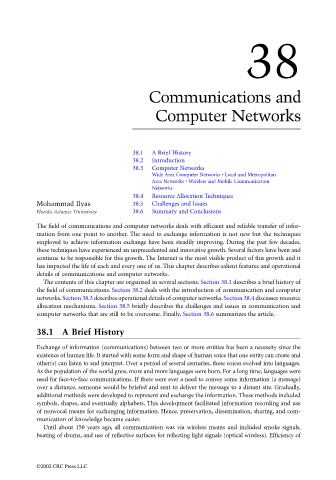Page 1068 - The Mechatronics Handbook
P. 1068
38
Communications and
Computer Networks
38.1 A Brief History
38.2 Introduction
38.3 Computer Networks
Wide Area Computer Networks • Local and Metropolitan
Area Networks • Wireless and Mobile Communication
Networks
38.4 Resource Allocation Techniques
Mohammad Ilyas 38.5 Challenges and Issues
Florida Atlantic University 38.6 Summary and Conclusions
The field of communications and computer networks deals with efficient and reliable transfer of infor-
mation from one point to another. The need to exchange information is not new but the techniques
employed to achieve information exchange have been steadily improving. During the past few decades,
these techniques have experienced an unprecedented and innovative growth. Several factors have been and
continue to be responsible for this growth. The Internet is the most visible product of this growth and it
has impacted the life of each and every one of us. This chapter describes salient features and operational
details of communications and computer networks.
The contents of this chapter are organized in several sections. Section 38.1 describes a brief history of
the field of communications. Section 38.2 deals with the introduction of communication and computer
networks. Section 38.3 describes operational details of computer networks. Section 38.4 discusses resource
allocation mechanisms. Section 38.5 briefly describes the challenges and issues in communication and
computer networks that are still to be overcome. Finally, Section 38.6 summarizes the article.
38.1 A Brief History
Exchange of information (communications) between two or more entities has been a necessity since the
existence of human life. It started with some form and shape of human voice that one entity can create and
other(s) can listen to and interpret. Over a period of several centuries, these voices evolved into languages.
As the population of the world grew, more and more languages were born. For a long time, languages were
used for face-to-face communications. If there were ever a need to convey some information (a message)
over a distance, someone would be briefed and sent to deliver the message to a distant site. Gradually,
additional methods were developed to represent and exchange the information. These methods included
symbols, shapes, and eventually alphabets. This development facilitated information recording and use
of nonvocal means for exchanging information. Hence, preservation, dissemination, sharing, and com-
munication of knowledge became easier.
Until about 150 years ago, all communication was via wireless means and included smoke signals,
beating of drums, and use of reflective surfaces for reflecting light signals (optical wireless). Efficiency of
©2002 CRC Press LLC

